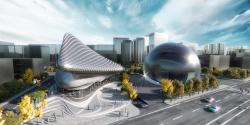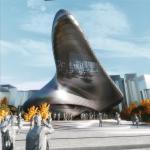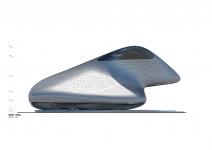THE BIGGEST CAMERA ON PLANET EARTH IS IN SEOUL!
Isn't the purpose of a Photography Museum to celebrate Photography? So why not crea te the biggest camera on planet Earth and celebrate the art of photography and the cit y of Seoul with an installation of a rooftop ‘Camera Obscura’ that marries past, present, and future into an experience that visitors will never forget. Photography makes our me mories valuable, fixing them for a moment, while life keeps rolling rapidly in time. From digital to analogical, from microscopic pictures to satellite images, Photography has bee n freezing those fleeting moments. And, before all that, there was what we can call the grandmother of Photography, the ‘Camera Obscura.’ And it is to this origin that we wan t to come back to present the first innovation of the camera properties and give both l ocals and tourists a landmark experience that will will provide Seoul with the Biggest Ca mera on Planet Earth. Our installation will also boost the city’s economy and tourism flo w, as visitors from all around the world, and all ages and profession, come to participat e in Seoul’s vibrant cultural scene and have the Museum’s as one of the main incentive s for their visit.
‘Camera Obscura’ on Seoul Photographic Art Museum roof-top.
Seoul Photographic Art Museum is located on the cultural and art facilities of Dobong-g u in the Northeastern part of the city, and our 'camera obscura' has the mission of doc umenting and providing a better understanding of Seoul’s history and the way it has m anaged to balance innovation and tradition. Our 'Camera Obscura' rooftop installation is an ideal way to showcase the developing skyline of Seoul’s city view at the exhibition r ooms and showcase the sky view at the top of the exhibition area in building.
This project aims to create a new experience for visitors by creating a ‘Camera Obscur a’ installation on top of the museum’s roof and exhibition rooms,would present for the visitor's snapshots from Seoul's changing and developing the city. The installation brings together a synthesis of ancient and new technology that adds value to the Seoul Photo graphic Art Museum’s mission of entertaining while educating its audience. This design will attract the interest of both photographers and general public making it a landmark and underlining the fact that the museum is actually the first Photographic Art Museum in seoul.The combination of education and entertainment also brings the history and fu ture of Photography in the same place and at the same time in a way that will make t he Museum’s building a perfect synthesis of past and future that we find is a thriving v alue in contemporary Seoul.
Our Camera Obscura will turn Seoul Photographic Art Museum into the first public buil ding in Seoul to host such a special and attractive design. One of the key values of ou
r proposal is to enhance the educational role of the building by using an invention, the ‘Camera Obscura’ which also work as a great introduction to the world of Photography for the citizens of Seoul. Visitors that stand around the gallery space will allow them to virtually walk among the clouds, using a technology that requires nothing but sunshine. Moreover, by tilting the lens of the camera, we will also be able to show segments of Seoul’s urban landscape, immersing visitors in a new reality and making them participat e in an actual living photography of the city.
In conclusion, we can think about this installation in a simple and fun way: it is the mu seum itself, with its roof-top camera and pinholes in exhibition rooms, who are taking a picture of the present skyline of Seoul and showing it to the visitor.
WHAT IS A CAMERA OBSCURA?
Camera obscura (from Latin, meaning “darkened room”) is a device that varies in size a nd can take the shape of a box or a whole room. A hole has been pierced on one of the sides or walls which lets the light into the box or room, projecting the image on th e other opposite wall or side. The device has been used in the past in scientific fairs an d even as circus attraction, which makes it a favourite for any kind of public. There are more complex camera obscuras that use mirrors to project image upwards and right-sid e up, and they can also have lenses sometimes.
HOW DOES THE CAMERA OBSCURA WORK?
A Law of Optics that the ancients had already discovered serves as the base for the Ca mera Obscura mechanism. Namely, light travels in a straight line, but when some of the rays pass through a small hole pierced on a thin material, instead of scattering, the rays cross the hole and reshape on the opposite wall (any flat surface held parallel to the h ole) as an upside down image. This peculiar phenomenon was described already the manuscripts of Leonardo da Vinci in the 15th century and by the mid-sixteenth century, lenses had begun to be used to increase the brightness and sharpness of the image.
HOW DOES THE ‘CAMERA OBSCURA’ WORK INSIDE THE MUSEUM
One of the systems comprised of two lenses and a large periscope mirror was installed on the very top of the building. Its closable and openable system. when ıts area needs a dark area, the pinhole will be closed to provide a dark atmosphere for exhibition. On event, the pinhole will be open to show visitors how it could be to realize a real camer a.This system provides that a great event and experience for users.
At the top of the roof surface on the west side has a mirror was used to reflect the i nverted image so it provides appears sky images on the middle of the gallery space on the event and educational programs.ıts could be arranged by controlling with the comp
uter.Thus the interior of the cloud chamber has trees, clouds, and blue sky projected ac ross the white cement walls on exhibition 3-4 area and gallery space which is located a t the center of the building.
At the top of the building, we will mount a plain mirror, protected by a hood and a wi ndow-pane. The mirror is angled so that natural light reflects downwards into the towe r. The light will pass through three lenses, bringing the focus onto the gallery space. Th e lenses also switch the sky view so that it appears upside down on the gallery space. The mechanism will be adaptable and orientable, according to the exhibition events. Wh en the main gallery space is darkened, our eyes adjust to the light and we will see see the reflected images.
WHAT IS THE PURPOSE OF THE CAMERA OBSCURA IN OUR BUILDING
The main purpose of the project is to use the structure and shape of the building itself as a big camera. The camera obscura idea on the top of the building will project the w ide sky that could be seen from the roof. It can also be used on the west and east sur faces of the building, which would allow the Camera to show Seoul’s urban landscape a cross the gallery space.
Now, just by walking on the gallery space that is in the center of the building, visitors can experience in real time lively scenes of the surrounding Seoul city. This kind of scie ntific device will give a wonderful experience for all kinds of local public, making the vis it a must for any tourist that happens to visit the city. In relation to the local and natio nal visitors, this installation will expand the educational opportunities, cultural and econo mic growth for the resident’s of the Northeastern region. Moreover, local residents, prof essional and amateur photographers will have the chance to profit from the museums c ollections and exhibitions. And all these cases, the ground floor space, in which the Ca mera Obscura would project the outside images, will be used for festivals, forums, and exhibitions that will further enhance the dynamic and lively nature of our installation.
ABOUT THE FORM ́S CONCEPT
“Photographic Art Museum Design ‘ sets itself in contrast to the block-like structures t hat surround it in Seoul, Korea. At the same time, this cultural center takes INSPIRATIO N from TAEKKYEON which is a traditional Korean martial art that makes use of fluid, r hythmic dance-like movements to strike or trip up an opponent. On the front side of th e building we can experience a cantilever movement through the south side that repres ents a KICK OF THE HUMAN such as TAEKKYEON dance movements, which are fluid, or ganic and strong in their emphasis. This has in its front a spectacular trapezoid in move ment, different in every angle: an open form that invites the public into its space. The overhanging structures on the front of the building double up as projecting roofs, guidi ng the visitor into the orientation area, Ticket hall, cafe and bookstore hall. The exposed
steel structure appears like a huge sculpture with decoratively alternating light and shad ow on the wide forecourt. Each of the angles of the building provide a different perspe ctive on a different angle so that visitors can share the exciting feeling the building co mmunicates while they are surrounded by its infrastructure.The overlapping, curved cont ours on the surface break out of the orthogonal urban grid pattern, attracting visitors magically.
Museum Design’s fluid architecture embodies an enlightened philosophical framework. T he centre’s fluid exterior surfaces rise from its surroundings to define a series of exhibiti on, education, and research spaces within, inviting the urban fabric of the city into the heart of building.The Museum rises up to 22 meters in height and covers an area of 84 5 square meters footprint closed area. Inside, the center of the building has an impressi ve spiral staircase that leads to the four-floors of the exhibition and education level as
a continuous and fluent design. The dynamic stair sculpture not only connects the exhi bitions and education levels between the orientation zone but also acts as a stage for t he flow of movement through the ‘vertical decorative element‘.
In total 6,658.92 gross square metres on the museum’s four floors where you can enjoy in real lifetime the photo experience and exhibitions of classic examples of 'Camera Obs cura.' The exhibition part will be comprised of optical illusions, puzzles, etc., providing g uests with dizzying alternate realities and tricks for the mind and the senses. Gamificatio n will be a key element of these exhibitions. Visitors are encouraged to get involved wit h everything, play with it all, and unlike a lot of learning centers, there is nothing in thi s one you are not allowed to touch. Its interior will be distributed over the 3rd and 4th floors, that hosts a wide variety of artworks of over 1,435 square meters of exhibition. It s particular external form does not allow the entry of the light. However, some of the e xterior facade panels would be made openable, closable, and adjustable for the times in which there will be need of daylight in that area.
INTERIOR LIGHTING DESIGN
We will develop a characteristic feeling of unison between fluid forms, daylight, and ligh ting at the Photographic Art Museum Design. Linear louvers follow the conceptual grid and filter the sunlight—ensuring a soft light for the structural curves. Electrical lighting i s concealed wherever possible. The black stairways create an intense contrast with their white luminous underside. Diffuse light flows through the building and builds a calm co unterpoint to the dynamic lines and the black and white material contrast. Homogeneo us basic illumination is ensured by dimmable fluorescent lamps fitted behind light-scatte ring translucent acrylic glass on either side of the entire length of the decorative ceiling design line.Aluminium louvers on ground floor serve as sunshades, regulated by the int elligent light management system in response to the position of the sun and the requir ed lighting. The system also controls the light output of the luminaires. This ensures a
perfect mixture of natural and artificial light that can be adjusted according to the existi ng daylight conditions. The stairs and pathways hugging the walls or freely spanning th e room are turned into carriers of light themselves. Their translucently shimmering unde rsides fitted with fluorescent lamps behind light-scattering foil and acrylic glass take on the appearance of boxes of light.
EXTERIOR LIGHTING DESIGN
The design of the exterior lighting is driven by fluidity and seamlessness. Thousands of l ight pixels on the surface remind the audience of a dream-like starry sky. Light patterns are following the structure pattern on the exterior surface. These waves stand in clear c ontrast to the crystalline exterior with the rectangular silvery facade pattern. Our tempor ary art installation and night shown on the exterior facade represents a dream-like lan dscape in which light patterns and changeable colours react to the flexible movement o f a membrane while embedded in her parametric architectural language.
The installation of the screen on the front bottom surface will represent a nice atmosph ere for visitors during the night.
The exterior lighting design will be tracing a remarkable path from fragmented light line s to a luminous fluidity by day and night.
SPACE FRAME STRUCTURE SYSTEM WITH RECTANGULAR OF SILVERY ALUMINIUM CLAD DING PANEL
The main structure of the Photographic Art Museum is a mix of reinforced concrete cor e (stairs,lifts and Wc walls), steel space frame structures (main frame) and composite be ams and decks. The skin of the building is clad with rectangulars of silvery aluminium cl adding panel with joint lighting elements for the exterior lightings of the building.The s pace frame is composed of a special steel tube-and-nodes that was deviced to utilize a space frame as its main structural element; the cladding is a curtain wall system compri sed of various specially fabricated panels. We focused, for example, on easy-to-clean ext ernal cladding materials because of the heavy air pollution. Moreover, the cladding will be gray. The rectangulars of silvery aluminium cladding panel come up and will be dirt- repellent. In general, all building systems are chosen to have high durability and a long lifetime and low maintenance efforts.
The floor’s structure is steel slab, thus providing a great mixed structure, in which two different structural systems work together by combining its properties, in this case, the s tiffness of the concrete and the versatility of the steel.
ABOUT THE CONSTRUCTION TECHNIQUE
Construction technique will be realized by robotic construction with high technologically
advanced solutions which will join each of the panels on exterior surfaces. This will save us cost and time during the construction phases.Digital panels will be located at bottom of front surfaces on building.At night,our building lighting will be opened and will attrac t residance users.
2019
2020
Project Name: First Photographic Art Museum in the world which has taken a picture by itself in Seoul
Architecture Firm: MASK Architects
Website: https://maskarchitects.com
Contact e-mail: [email protected]
Firm Location: Özdeniz sokak no:16/4 İstanbul,Turkey
German office: will be open soon
Completion Year: not clear
Site Area: 2,500 M2
Gross Built Area: 6,658.92 m2
Project location: 70,Madeul-ro 13-gil ,Dubong,Seoul
Lead Architects: Öznur Pınar Çer
Lead Architects e-mail: [email protected]
Design Team: Öznur Pınar ÇER
Technical Team : Sohyun Jeon ,Ernesto Estrella Cozar,
Clients: Seoul Metropolitan Government
Engineering: Mask Architects
Landscape: Mask Architects
Consultants: Tümer design Studio – Sertaç Tümer
Collaborators Local Architecture Office: SOBO Architects
Favorited 1 times




























